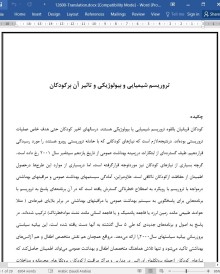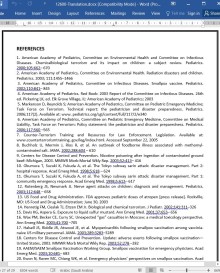
دانلود مقاله تروریسم شیمیایی و بیولوژیکی و تاثیر آن بر کودکان
چکیده
کودکان قربانیان بالقوه تروریسم شیمیایی یا بیولوژیکی هستند. درسالهای اخیر کودکان حتی هدف خاص عملیات تروریستی بوده اند. درنتیجه،لازم است که نیازهای کودکانی که با حادثه تروریستی روبرو هستند را مورد رسیدگی قراردهیم. طیف گسترده ای از ابتکارات درزمینه بهداشت عمومی از تاریخ یازدهم سپتامبر سال 2001 رخ داده است. گرچه بسیاری از نیازهای کودکان نیز موردتوجه قرارگرفته است، اما دربسیاری از موارد این طرح ها درحصول اطمینان از حفاظت ازکودکان ناکافی است. علاوه براین، آمادگی سیستمهای بهداشت عمومی و مراقبتهای بهداشتی درمواجه با تروریسم با رویکرد به اصطلاح خطرناکی گسترش یافته است که در آن برنامه های پاسخ به تروریسم با برنامه هایی برای پاسخگویی به سیستم بهداشت عمومی یا مراقبتهای بهداشتی در برابر بلایای غیرعادی ( مثلا حوادث طبیعی مانند زمین لرزه یا فاجعه پاندمیک و یا فاجعه انسانی مانند نشت موادخطرناک) ترکیب شده اند. در پاسخ به اصول و برنامه های جدیدی که طی 5 سال گذشته به آنها دست یافته شده است، این بیانیه سیاستی بروزرسانی بیانیه سیاستهای سال2000را ارائه می دهد. درواقع همچنان هم نقش متخصص اطفال و هم آژانس های بهداشتی تاکید می-شود و تنها تلاش هماهنگ متخصصان اطفال و بهداشت عمومی می تواند اطمینان حاصل کند که نیازهای کودکان ازجمله پروتکلهای اورژانس در مدارس و مراکز مراقبت ازکودکان، پروتکل های محرمانه و مداخلات بهداشتی روان موفق خواهد بود.
معرفی
در آوریل2000،کمیته آمریکایی آکادمی اطفال (AAP) درمورد بهداشت محیط و کمیته بیماری های عفونی گزارش فنی را با عنوان "تروریسم شیمیایی- بیولوژیکی و تاثیر آن برکودکان" منتشرکرد. رویدادها تا آن زمان، ازجمله حمله سارین درسال 1995در توکیو و ژاپن آشکارساخته بود که اقدامات تروریسم داخلی می تواند با تأثیر قابل توجهی برسلامت کودکان صورت گیرد. از زمان انتشارگزارش فنی2000، بسیاری از اعمال تروریستی شیمیایی و بیولوژیکی ازجمله انتشار اسپورهای سیاه زرد از طریق سیستم پستی ایالات متحده، آلودگی موادغذایی با موادشیمیایی سمی درگرند راپیدز، میشیگان و فرنوی، کالیفرنیا و شناسایی نامه های ریسین لندن در یک پست در کارولینای جنوبی رخ داده است.
بلافاصله پس از 11 سپتامبر 2001، حملات تروریست به ایالات متحده که خیلی زود توسط انتشارگرهای سیاه پوست دنبال شد، AAP با شناسایی نیاز به رسیدگی به تاثیر تروریسم برکودکان، مجموعه ای از اقدامات بی سابقه ای را آغازکرد. این اقدامات شامل (1) تشکیل نیروی عملیاتی AAP در بررسی موردی تروریسم، (2) ایجاد وب سایت جامع درصفحه اصلی AAP بود که به ارائه اطلاعات درمورد تروریسم و تاثیر آن برکودکان اختصاص داده شد. (3) انتشار گزارش فنی" پرتو بلایا و کودکان"، (4) انتشار بیانیه سیاسی درمورد ایمن سازی در برابر آبله، (5) علاوه براین، کتاب قرمز توصیف سلاح های زیستی و مدیریت بیماریهایی که آنها تولید می کنند، (6) انتشار یک گزارش فنی و بیانیه سیاسی درمورد متخصصان کودکان و آماده سازی درمواجه با بیماری، 7) انتشار سی دی رام "احساساتی که به بررسیهای بیش ازحد نیاز دارند"که بمنظور برخورد با پیامدهای روانی تروریسم برکودکان طراحی شده است.
توصیه های دولت
1- نیازهای کودکان باید درتمام تلاشهای آمادگی درسطح فدرال، ایالت، منطقه ای و محلی موردتوجه قرارگیرد.
2- توصیه های انجام شده توسط کمیته مشورتی ملی کودکان و تروریسم طراحی شده تا اطمینان حاصل شود که کودکان دربرنامه ریزی پاسخ اضطراری گنجانده شده اند.
3- سازمانهای بهداشت عمومی باید برای کمک به مدارس و نواحی مدرسه درتلاشهای انجام شده تلاشهای هماهنگی انجام دهند.
برنامه های واکنش اضطراری مدارس باید به مدارس فردی و محل آنها، جمعیت، کارکنان و منابع آن اختصاص داده شود.
4- DMATsایجاد شده توسط سیستم پزشکی فاجعه ملی نقش کلیدی دریک حادثه تلفات جسمی شامل کودکان نقش مهمی ایفا خواهدکرد. آموزش کودکان در این تیمها باید جامع باشد. ایجاد برنامه های DMAT آموزش اطفال مضاعف نیز باید درنظرگرفته شود.
5- سازمانهای بهداشت عمومی باید بطورفعال به بیمارستانها، ادارات اطفال، CHC ها و دیگر مراکز درمانی کمکهای لازم را ارائه کنند تا اطمینان حاصل شود که آنها آماده پاسخگویی به یک حادثه تروریستی شیمیایی یا بیولوژیکی هستند که شامل کودکان می شود.
6- مادامیکه تامین بودجه برای آمادگی فوری ادامه می یابد، نیازهای کودکان همیشه باید درمیان معیارهای عملکرد و تحویل دادنیها قرارگیرد.
ABSTRACT
Children remain potential victims of chemical or biological terrorism. In recent years, children have even been specific targets of terrorist acts. Consequently, it is necessary to address the needs that children would face after a terrorist incident. A broad range of public health initiatives have occurred since September 11, 2001. Although the needs of children have been addressed in many of them, in many cases, these initiatives have been inadequate in ensuring the protection of children. In addition, public health and health care system preparedness for terrorism has been broadened to the so-called all-hazards approach, in which response plans for terrorism are blended with plans for a public health or health care system response to unintentional disasters (eg, natural events such as earthquakes or pandemic flu or manmade catastrophes such as a hazardous-materials spill). In response to new principles and programs that have appeared over the last 5 years, this policy statement provides an update of the 2000 policy statement. The roles of both the pediatrician and public health agencies continue to be emphasized; only a coordinated effort by pediatricians and public health can ensure that the needs of children, including emergency protocols in schools or child care centers, decontamination protocols, and mental health interventions, will be successful.
INTRODUCTION
In April 2000, the American Academy of Pediatrics (AAP) Committee on Environmental Health and Committee on Infectious Diseases published the technical report “Chemical-Biological Terrorism and Its Impact on Children.”1 Events until that time, including the 1995 sarin attack in Tokyo, Japan, had made clear the possibility that acts of domestic terrorism can occur, with significant impact on the health of children. Since publication of the 2000 technical report, many additional acts of chemical and biological terrorism have occurred, including the release of anthrax spores through the US postal system, intentional food contamination by toxic chemicals in Grand Rapids, Michigan, and Fresno, California, and the identification of ricin-laden letters in a post office in South Carolina.
Immediately after the September 11, 2001, terrorist attacks in the United States, which soon were followed by anthrax releases, the AAP, recognizing the need to address the impact of terrorism on children, initiated a series of unprecedented actions. These actions included (1) formation of the AAP Task Force on Terrorism, (2) creation of a comprehensive Web site on the AAP home page devoted to providing information on terrorism and its impact on children (www.aap.org/ terrorism/index.html), (3) publication of the technical report “Radiation Disasters and Children,”2 (4) publication of a policy statement on smallpox immunization,3(5) an addition to the Red Book of descriptions of biological weapons and management of the diseases they produce,4 (6) publication of a technical report5 and policy statement6 on the pediatrician and disaster preparedness, and (7) publication of the CD-ROM Feelings Need Checkups Too, designed to address mental health consequences of terrorism in children (www.aap.org/profed/ childrencheckup.htm).
RECOMMENDATIONS TO GOVERNMENT
1. The needs of children should be addressed in all preparedness efforts at the federal, state, regional, and local levels.
2. All recommendations made by the National Advisory Committee on Children and Terrorism (www.bt.cdc. gov/children/recommend.asp), designed to ensure that children are included in emergency-response planning, should be implemented.
3. Public health agencies should make a concerted effort to assist schools and school districts in their preparedness efforts. Emergency-response plans for schools should be tailored to the individual school and its location, population, staff, and resources.
4. DMATs created by the National Disaster Medical System will play a key role in a mass-casualty incident involving children. The pediatric training of these teams should be comprehensive. Creation of additional pediatric DMATs should be considered.
5. Public health agencies should continue to actively provide assistance and resources to hospitals, pediatric offices, CHCs, and other health care facilities to ensure that they are prepared to respond to a chemical or biological terrorist incident that involves children.
6. As funding for emergency preparedness continues, the needs of children should always be included among the deliverables and performance benchmarks.
چکیده
معرفی
عوامل نگرانی
مواد شیمیایی
عوامل عصبی
آبزیان
عوامل خفه کن
سیانوژن
عوارض جانبی
عوامل زیستی
ابله
ریسین
قرارگرفتن درمعرض اسکالرهای سلاح های شیمیایی و زیست شناختی
آسیب پذیری خاص کودکان
آمادگی بهداشت و سلامت عمومی
تمامی رویکردهای خطرناک
نظارت سندرمی
نقشهای دولتی جدید در آمادگی اضطراری
مسائل سیستم درآمادگی برای تروریسم شیمیایی و زیست شناختی
آمادگی مرکز آموزش مدرسه و کودک
آمادگی بیمارستان
مرکز بهداشت عمومی مرکز آمادگی جامعه
آمادگی اداره اطفال
ظرفیت انبساط
سلامت روان
آمادگی فرد با خانواده
توصیه های پزشکان اطفال
توصیه های دولت
منابع
ABSTRACT
INTRODUCTION
AGENTS OF CONCERN
Chemicals
Nerve Agents
Vesicants
Choking Agents
Cyanogens
Incapacitating Agents
Biological Agents
Smallpox
Ricin
EXPOSURE VECTORS FOR CHEMICAL AND BIOLOGICAL WEAPONS Exposure t
SPECIFIC VULNERABILITIES IN CHILDREN
PUBLIC HEALTH PREPAREDNESS
The All-Hazards Approach
Syndromic Surveillance
New Governmental Roles in Emergency Preparedness
SYSTEMS ISSUES IN PREPAREDNESS FOR CHEMICAL AND BIOLOGICAL TERRORISM
School and Child Care Center Preparedness
Hospital Preparedness
Community Health Center Preparedness
Office Preparedness
Surge Capacity
Mental Health
Individual/Family Preparedness
RECOMMENDATIONS TO PEDIATRICIANS
RECOMMENDATIONS TO GOVERNMENT
REFERENCES
- اصل مقاله انگلیسی با فرمت ورد (word) با قابلیت ویرایش
- ترجمه فارسی مقاله با فرمت ورد (word) با قابلیت ویرایش، بدون آرم سایت ای ترجمه
- ترجمه فارسی مقاله با فرمت pdf، بدون آرم سایت ای ترجمه



